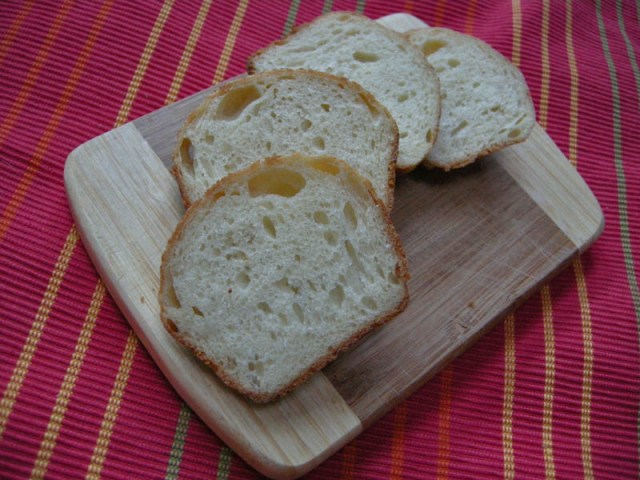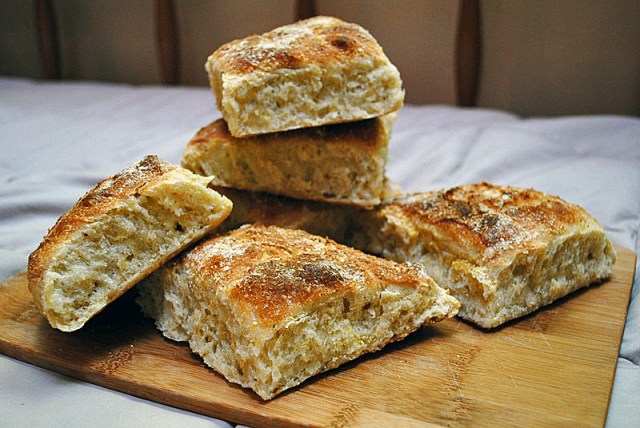Back in the 70’s, bakers in Netherlands realized that by coating bread dough with a thick paste made of rice flour, sugar, oil, and yeast, a crust would form during baking and develop cracks, giving each bread a unique pattern, akin to a tiger’s coat. Tiger Bread, also known in the US as Dutch Crumb, is a lot of fun to make and actually very easy, no wild yeast, no intense kneading. A perfect recipe to make with kids, as they will have a blast with the changes in the bread as it bakes. For my tiger rolls, I used the Vienna bread recipe made earlier during the Bread Bakers’ Apprentice Challenge. Peter Reinhart gives the option of the Dutch crumb at the end of that chapter, but not until folks at The Fresh Loaf forum raved about it I decided to re-visit it.
VIENNA BREAD WITH DUTCH CRUMB
(adapted from The Bread Bakers Apprentice)
Pate fermentee (made the day before)
140 g bread flour
2.5 g salt
1/2 teaspoon instant yeast and
100 g water at room temperature
Mix all ingredients, knead briefly and let it rise at room temperature for 1 to 2 hours. Place the mixture in the fridge overnight, remove from the fridge one hour before making the bread.
Dough:
185g pate fermentee (you won’t use the full amount made)
170g unbleached bread flour
7g sugar
4.5g salt
2g instant yeast (3/4 tsp)
1/2 egg, slightly beaten
7g unsalted butter, melted and slightly cooled
85-100 ml water, lukewarm (90 – 100 F)
Dutch Crumb Paste:
1 Tbs bread flour
3/4 cup rice flour
3/4 tsp. instant yeast
2 tsp. sugar
1/4 tsp. salt
2 tsp oil
8 tbsp water (or a little more) to make a thick paste.
Remove the pate fermentee from the refrigerator, cut it into 5-6 small pieces, cover and let it at room temperature for about 1 hour.
Stir together the flour, sugar, salt, and yeast in a large bowl. Add the pate fermentee pieces, the beaten half egg, butter, and 85 ml of the water. Stir together with a large metal spoon, or with your hands, until the ingredients form a ball. If too dry, add the rest of the water (I did). Let it rest for 20 minutes.
Knead by folding 3 times at 20 minutes intervals. At the end of the third cycle of folding (at 1 hour fermentation), leave the dough covered, undisturbed, for another hour. Cut the dough into 6 equal pieces, pre-shape them as balls. Let them rest for 15 minutes.
Make the topping layer by mixing all the ingredients for the Dutch crumb to form a thick paste. Shape each bread as rolls, being careful not to deflate the dough too much. Place them on a floured surface without touching, apply a thick coating of crumb paste on the surface using a silicone brush or your fingers. Let them rise for 60-90 minutes (they should not double in size).
Place the rolls (covered) in a 450F oven, turning the temperature down to 400F as soon as you start baking. Remove the cover after 20 minutes, and continue baking them for a total of 30 to 35 minutes, until golden brown. Cool the rolls on a rack for one hour before eating.
ENJOY!
to print the recipe, click here
Comments: I made this bread twice on consecutive weekends, the first time I shaped it as a single loaf, but had some trouble to fit it in my toaster oven. This time I made small rolls and baked then in a tray of large muffins, covered with an improvised lid of heavy duty aluminum foil. This was the only way I could bake them all at the same time in my small oven. After 20 minutes baking, I removed the aluminum foil, quickly (and carefully) dumped the breads out of the muffin tin, and allowed them to continue baking sitting on the oven’s rack.
The crust is visually appealing, but what’s even better is its taste. I actually had to control myself not to peel it off leaving the naked roll behind. 😉 It is sweet and salty at the same time, crunchy, deliciously addictive.
 The crumb is delicate, and the bread, thinly sliced, a perfect accompaniment to a bowl of soup, a simple salad, or a slice of Iberico cheese (one of our latest addictions).
The crumb is delicate, and the bread, thinly sliced, a perfect accompaniment to a bowl of soup, a simple salad, or a slice of Iberico cheese (one of our latest addictions).
I am submitting this post to Susan’s Yeastspotting…
ONE YEAR AGO: Banana Bread (something I’ve been craving lately….)









































